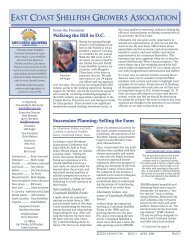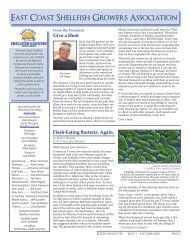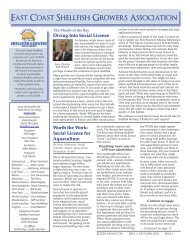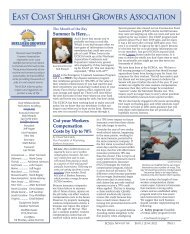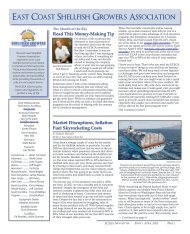ECSGA newsletter December 2022
Articles include: Why the ISSC conference is vital to your business; More on bird interactions with floating shellfish gear; What does the market for shellfish look like in the EU? Stay out of trouble with the IRS by following these tips; Mass oyster mortalities in North Carolina still a mystery; Some new reseach on microplastics in oysters and mussels; Oyster larvae respond to underwater sound! Hurricane Fiona causes millions in losses in Prince Edward Island, Canada; A full preview of all the upcoming shellfish aquaculture conferences this winter; Why do special interest groups have more clout than science? and NOAA's 5-year plan for aquaculture development.
Articles include: Why the ISSC conference is vital to your business;
More on bird interactions with floating shellfish gear;
What does the market for shellfish look like in the EU?
Stay out of trouble with the IRS by following these tips;
Mass oyster mortalities in North Carolina still a mystery;
Some new reseach on microplastics in oysters and mussels;
Oyster larvae respond to underwater sound!
Hurricane Fiona causes millions in losses in Prince Edward Island, Canada;
A full preview of all the upcoming shellfish aquaculture conferences this winter;
Why do special interest groups have more clout than science? and
NOAA's 5-year plan for aquaculture development.
Create successful ePaper yourself
Turn your PDF publications into a flip-book with our unique Google optimized e-Paper software.
— Continued from page 8<br />
NC Oyster Mortalities<br />
in the weeks following a freshening<br />
event from the intense<br />
but brief rains in July, which is<br />
in line with previous mortality<br />
events following environmental<br />
perturbations. Anecdotally, we<br />
do not see the same magnitude<br />
of mortality in most wild oyster<br />
populations, which has led us<br />
to address susceptibility across<br />
wild and cultured oyster lines.<br />
With follow-on funding from the<br />
North Carolina Policy Collaboratory,<br />
we are working with the<br />
shellfish aquaculture industry<br />
and partners at University of<br />
North Carolina Wilmington<br />
and the Duke University Marine<br />
Laboratory to understand<br />
how growers can best adapt and<br />
respond to repeated mortality<br />
events, including shifts in<br />
planting and harvest schedules<br />
to keep larger, more susceptible<br />
oysters out of the water during<br />
warm, high-risk summer<br />
months; and, if and when possible,<br />
moving oysters to lowersalinity<br />
nursery habitats for the<br />
majority of grow-out.<br />
Continued investment in USDA<br />
and private insurance programs,<br />
and educating growers about insurance<br />
options, will be critical<br />
to sustaining the industry while<br />
we work to better understand<br />
the conditions underpinning<br />
these events.<br />
NAVIGATING THE WATERS OF<br />
REGULATORY REQUIREMENTS<br />
Effectively managing your businesses requires careful<br />
regulatory compliance.<br />
We represent a wide range of shellfish aquaculture<br />
enterprises. Our work ranges from project permitting and<br />
regulatory compliance, to litigation, tax, employment, real<br />
estate, and legislation and policy matters.<br />
We have prepared testimony and presented the views of<br />
industry coalitions and aquaculture clients to the U.S.<br />
Congress, state legislatures, and local, state, and federal<br />
regulatory agencies. A national firm with offices in major<br />
cities including Washington D.C., Boston, New York,<br />
Charlotte, and Seattle, we bring both local and national<br />
perspectives to meet the needs of industry clients.<br />
Before embarkiing on your next legal challenge, consider<br />
the resources we have to offer.<br />
K&L Gates LLP. Global counsel across five continents. Learn more at klgates.com<br />
NOAA Releases<br />
Aquaculture<br />
Strategic Plan<br />
In October NOAA published<br />
its first-ever Five-Year Strategic<br />
Plan for Aquaculture to<br />
guide the agency’s work from<br />
2023 to 2028.<br />
“Through this plan, NOAA<br />
will support a thriving, resilient,<br />
and inclusive U.S. aquaculture<br />
industry as part of a<br />
competitive domestic seafood<br />
sector,” said NOAA Fisheries<br />
Assistant Administrator Janet<br />
Coit.<br />
“This plan will act as a framework<br />
to guide NOAA’s Aquaculture<br />
Program, set priorities<br />
to achieve our mission, and<br />
support NOAA’s vision of<br />
healthy and resilient<br />
ecosystems, communities, and<br />
economies,” Coit added.<br />
The Strategic Plan articulates<br />
a vision for an industry that<br />
supports jobs, expands access<br />
to nutritious domestic seafood,<br />
and reinforces healthy coastal<br />
and ocean ecosystems in a<br />
changing environment. This<br />
is supported by the program’s<br />
mission of providing science,<br />
services and policies that create<br />
conditions for opportunity<br />
and growth of sustainable U.S.<br />
aquaculture.<br />
The plan contains four key<br />
goals to expand sustainable<br />
aquaculture:<br />
1. Manage Sustainably<br />
and Efficiently: Improve the<br />
regulatory processes for sustainable<br />
coastal and marine<br />
aquaculture through collaboration<br />
with partners.<br />
2. Lead Science for Sustainability:<br />
Use world-class<br />
science expertise to meet<br />
management and industry<br />
needs for a thriving seafood<br />
production sector and share<br />
this knowledge broadly.<br />
3. Educate and Exchange<br />
Information: Build awareness<br />
and support for coastal,<br />
marine and Great Lakes<br />
aquaculture through twoway<br />
communication with<br />
diverse stakeholders and<br />
partners.<br />
4. Support Economic<br />
Viability and Growth: Facilitate<br />
a robust aquaculture<br />
industry that thrives as a<br />
key component of a resilient<br />
seafood sector.<br />
When farmed seafood is<br />
produced responsibly, as it<br />
is in the United States, it is<br />
good for people, good for the<br />
economy and good for the<br />
planet. Seafood, both wild<br />
and farmed, is one of the best<br />
sources of nutrients essential<br />
for human well-being. Aquaculture<br />
is a resource-efficient<br />
means to produce protein; it<br />
helps to improve nutrition and<br />
food security while supporting<br />
local economies in the United<br />
States and around the world.<br />
As a climate-smart form of<br />
food production, aquaculture<br />
will be increasingly important<br />
as we face a changing climate<br />
and uncertain future environmental<br />
conditions.<br />
Aquaculture already provides<br />
over half the global seafood<br />
supply, and demand for seafood<br />
is poised to grow both<br />
globally and domestically.<br />
Currently, the U.S. imports<br />
at least 70% of its seafood.<br />
While we continue to sustainably<br />
manage our wild harvest<br />
fisheries, we cannot meet the<br />
increasing domestic demand<br />
for seafood through wild<br />
fisheries alone. Increasing the<br />
sustainable farming of finfish,<br />
shellfish and macroalgae is<br />
essential to increase domestic<br />
seafood supplies and provide a<br />
source of safe, nutritious and<br />
sustainable seafood for consumers<br />
in the United States<br />
and around the globe.<br />
To read the full plan visit:<br />
media.fisheries.noaa.<br />
gov/<strong>2022</strong>-10/Strategic-Plan-<br />
102422-web.pdf.<br />
<strong>ECSGA</strong> Newsletter<br />
Page 12 Issue 4 <strong>December</strong> <strong>2022</strong>




